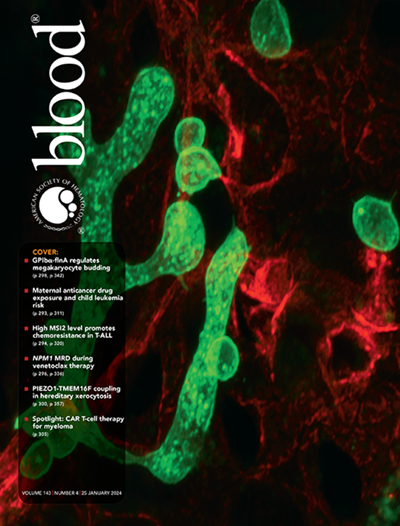ENHANCE-3研究:venetoclax和阿扎胞苷联合麦格罗单抗或安慰剂治疗不适合强化治疗的未治疗AML。
IF 21
1区 医学
Q1 HEMATOLOGY
引用次数: 0
摘要
急性髓性白血病(AML)患者不适合强化化疗(IC)的治疗选择有限。3期ENHANCE-3研究旨在确定当任一种药物与venetoclax和阿扎胞苷联合使用时,马格罗单抗(马格罗单抗组)是否优于安慰剂(对照组)。先前未接受治疗的不符合IC治疗的AML成人患者被随机分配接受magrolimab(第1天和第4天1mg /kg,第8天15mg /kg,第11天和第15天30mg /kg,然后每周接受5周,然后每2周一次)或安慰剂,venetoclax(第1200天100mg,第2天200mg,之后每天400mg)和阿扎胞苷(75mg /m2,第1-7天),28天为一个周期。主要终点是总生存期(OS);主要次要终点包括完全缓解(CR)率和安全性。在对378名患者进行随机分组后,由于无效,该试验在预先指定的中期分析中停止。在最终分析中,中位随访时间为7.6个月(单抗组)vs 7.4个月(对照组),中位OS为10.7 vs 14.1个月(HR, 1.178 [95% CI, 0.848-1.637])。6个周期内的CR率分别为41.3%和46.0%。在venetoclax和阿扎胞苷的基础上添加magroliumab导致更多致命不良事件(19.0%对11.4%),主要是由5级感染(11.1%对6.5%)和呼吸事件(2.6%对0%)引起的。两组间任何级别感染、发热性中性粒细胞减少和中性粒细胞减少的发生率相似。这些结果突出了改善不符合IC治疗条件的AML患者预后的困难。该试验在www.clinicaltrials.gov注册为#NCT05079230。本文章由计算机程序翻译,如有差异,请以英文原文为准。
The ENHANCE-3 study: venetoclax and azacitidine plus magrolimab or placebo for untreated AML unfit for intensive therapy.
Patients with acute myeloid leukemia (AML) ineligible for intensive chemotherapy (IC) have limited treatment options. The phase 3 ENHANCE-3 study aimed to determine whether magrolimab (magrolimab arm) was superior to placebo (control arm) when either was combined with venetoclax and azacitidine. Adults with previously untreated AML who were ineligible for IC were randomized to receive magrolimab (1 mg/kg on days 1 and 4, 15 mg/kg on day 8, 30 mg/kg on days 11 and 15, then weekly for 5 weeks, then every 2 weeks) or placebo, venetoclax (100 mg on day 1, 200 mg on day 2, and 400 mg daily thereafter), and azacitidine (75 mg/m2 days 1-7) in 28-day cycles. The primary endpoint was overall survival (OS); key secondary endpoints included complete remission (CR) rate and safety. After randomization of 378 patients, the trial was stopped at a prespecified interim analysis due to futility. At final analysis, with median follow-up of 7.6 months (magrolimab arm) vs 7.4 months (control arm), median OS was 10.7 vs 14.1 months (HR, 1.178 [95% CI, 0.848-1.637]). The CR rate within 6 cycles was 41.3% vs 46.0%. Addition of magrolimab to venetoclax and azacitidine resulted in more fatal adverse events (19.0% vs 11.4%), primarily driven by grade 5 infections (11.1% vs 6.5%) and respiratory events (2.6% vs 0%). There were similar incidences of any-grade infections, febrile neutropenia, and neutropenia between arms. These results highlight the difficulty in improving outcomes for patients with AML ineligible for IC. This trial was registered at www.clinicaltrials.gov as #NCT05079230.
求助全文
通过发布文献求助,成功后即可免费获取论文全文。
去求助
来源期刊

Blood
医学-血液学
CiteScore
23.60
自引率
3.90%
发文量
955
审稿时长
1 months
期刊介绍:
Blood, the official journal of the American Society of Hematology, published online and in print, provides an international forum for the publication of original articles describing basic laboratory, translational, and clinical investigations in hematology. Primary research articles will be published under the following scientific categories: Clinical Trials and Observations; Gene Therapy; Hematopoiesis and Stem Cells; Immunobiology and Immunotherapy scope; Myeloid Neoplasia; Lymphoid Neoplasia; Phagocytes, Granulocytes and Myelopoiesis; Platelets and Thrombopoiesis; Red Cells, Iron and Erythropoiesis; Thrombosis and Hemostasis; Transfusion Medicine; Transplantation; and Vascular Biology. Papers can be listed under more than one category as appropriate.
 求助内容:
求助内容: 应助结果提醒方式:
应助结果提醒方式:


